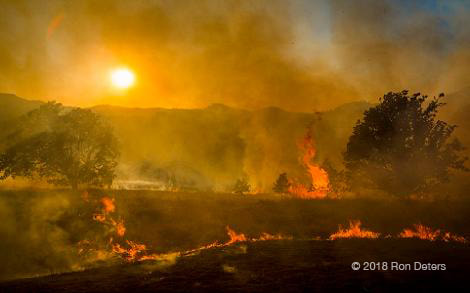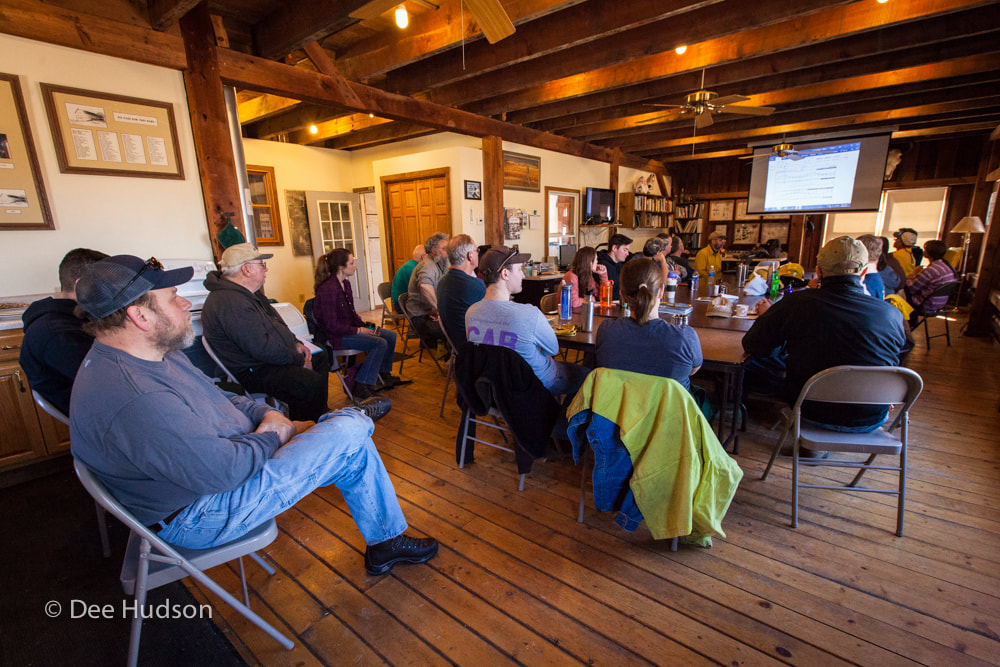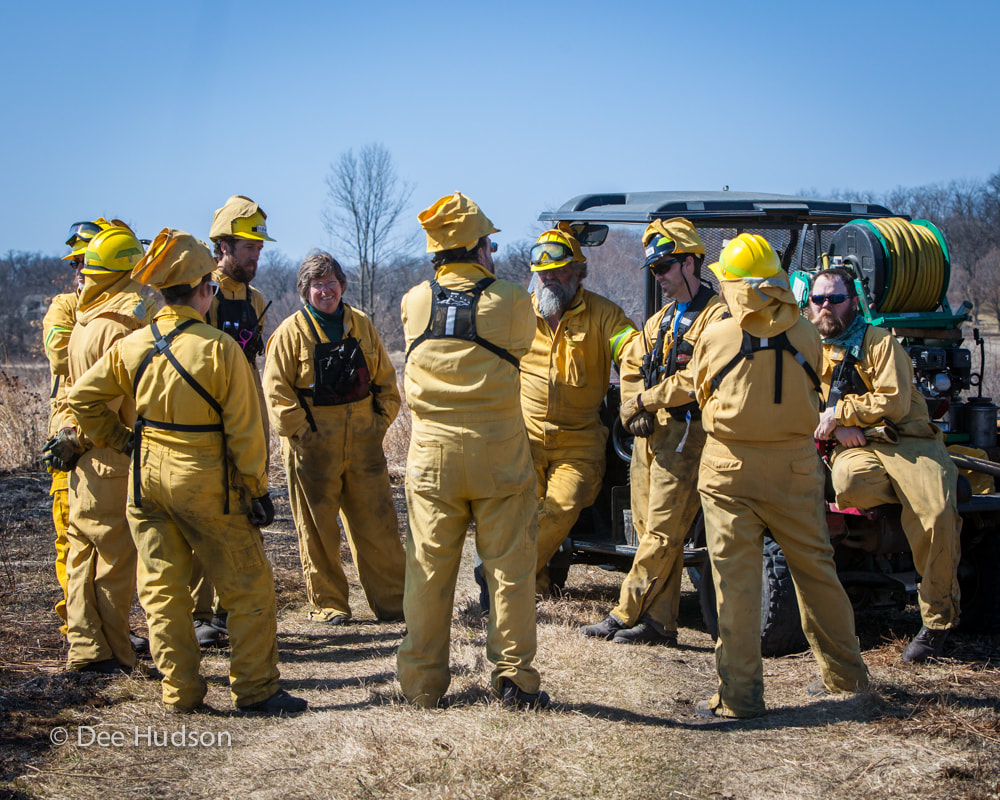|
Yes! Spring fire season is here! As a Nachusa Grasslands’ fire crew member, it is time to get ready. The Nature Conservancy has three fire crew requirements:
Nachusa Grasslands held its 2018 Refresher exercise on March 10. Folks fresh out of S-130/S-190 attended, along with the regular, seasoned crew. Whatever the team member’s experience, the refresher has always been a day where we all take away lessons. First task of the day — Field test. It helps to take the test in a group. Camaraderie is regenerated as we chat and laugh. Those of the crew who benefit from being taller help those of us who are shorter by setting the pace of four miles per hour. This portion of the day has been nicknamed the “pack test” by Nachusa’s fire crew. Do we call it the pack test because something unconsciously wonderful occurs during the hike that helps reinforce communication and cohesiveness that a crew will need during an actual burn? Are we working together similar to a wolf pack, thus, a “pack” test? Hmm. Next — Classroom. This is the time to review our various burning methods and first aid/safety. This portion of the day is perhaps the most difficult because we all prefer to be outdoors. There is the benefit that someone typically brings homemade goodies to share. Finally, we head outdoors to practice! We split into groups and work through various stations.
Equipment Review. If you have ever burned somewhere else, you immediately appreciate the plethora of tools available at Nachusa. The trucks with large water tanks are helpful. The trucks are not as maneuverable as a utility vehicle (UTV), but the big tanks are great because large volumes of water are available on the fire line. In contrast to the trucks, we have UTV’s with smaller water tanks that can access tight or muddy areas. You can imagine this luxury if you have hauled a water backpack onto a fire line. The trucks and UTV’s are only a sampling of Nachusa’s equipment. Of course, equipment requires preventive maintenance. Before every fire, all vehicles and tools are inspected for common issues. For example:
Vehicle Extraction. The best way to to avoid pulling a vehicle out of the mud is to not get it stuck. Ah, comedian. Truly. . . we talk about being mindful of the terrain, when to have a vehicle in low versus high, four-wheel drive versus two-wheel, and differential lock or not. Then we simulate a stuck vehicle and practice using the new winches on the UTV’s. The new winches are nifty because they have a “remote” that you plug into the anchor vehicle and therefore operate the winch at a safer distance from the vehicles. With this method, you can get a better perspective of the extraction process and know more quickly if the mired vehicle is clear of the mud. Cool. Vehicle backup. We use the trucks for this station. When the trucks are loaded with the water tanks, hose reels, and water pumps, it is difficult to see behind the vehicle in order to back up safely. It is extremely important to have a spotter to help back up without incident — property damage or, worse, personal injury. Verbal communication and clear hand signals are necessary between driver and spotter. We practice making a straight-on backup, and then also a straight-on backup with a 90° turn — all between cones! Yikes! Spot Fire Simulation. By far, the most anticipated station of the day — working with fire! Our burn boss, Bill Kleiman, sets a fire in the prairie and radios a “spot fire” to the waiting crew, asking for resources. We respond, separately attack the fire flanks as two teams, and extinguish the spot fire as quickly as possible, always mindful of safety. The exercise is intended to remind us how to actually approach an unwanted fire, and how to quickly and purposefully move to extinguish the fire before it is out of hand. In speedy succession, we think about the crew member up front working the fire hose and “eating some smoke” — might that person need relief? Can the driver see through the smoke? Is the now blackened area cool enough to drive over? Is somebody tending the hose so that it does not catch on fire? What is the wind doing and how is the fire moving? What type of fuels are we in? Is the fire out with the first pass or do we need more resources? Is the fire completely out? Any flare ups — double check, double check, double check. We gather for our “after action” review; what was good and what could we have done better? Let’s do another! When our refresher exercises are complete, we head back to the Headquarters Barn for some snacks, beverages, more camaraderie, and end with the feeling of a day well spent. I love the whole burning process — from initial preparation to the actual burn — to witnessing the various habitats rejuvenate and thrive following the burns. Do you want to be a part of prescribed fire? Contact us, and we hope to see you on the fire line soon! This blog post was written by Gwen D., a volunteer steward at Nachusa Grasslands.
7 Comments
Charles Larry
4/9/2018 12:42:14 pm
Wonderful, Gwen! Informative and entertaining! And the photos add greatly to the storytelling.
Reply
Alan Meier
4/9/2018 04:24:35 pm
Great article, Gwen! You covered everything well.
Reply
Paul Swanson
4/11/2018 10:30:54 am
Great Job, Gwen! Your story telling and Dee's photos capture the annual fire crew refresher event well!
Reply
Jeremy Milnes
4/16/2018 04:08:57 pm
Sounds like a great day! Always good to read things written from such a personal perspective. Excellent description of how nachusa is maintained. Well done!!
Reply
Your comment will be posted after it is approved.
Leave a Reply. |
Blog CoordinatorDee Hudson
I am a nature photographer, a freelance graphic designer, and steward at Nachusa's Thelma Carpenter Prairie. I have taken photos for Nachusa since 2012. EditorJames Higby
I have been a high school French teacher, registered piano technician, and librarian. In retirement I am a volunteer historian at Lee County Historical and Genealogical Society. Categories
All
Archives
January 2024
|
CONNECT WITH US |
|











 RSS Feed
RSS Feed